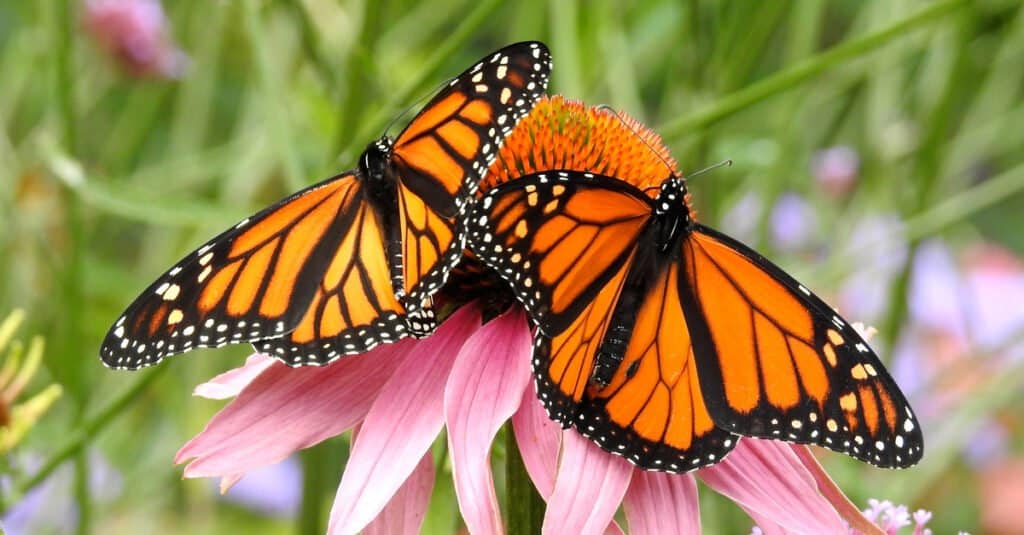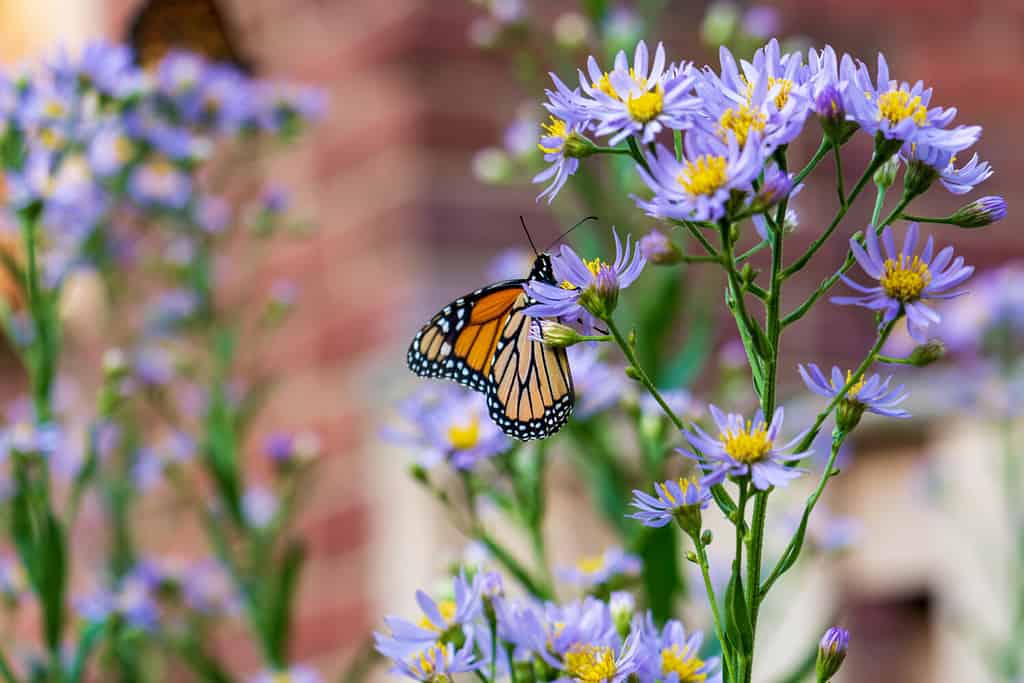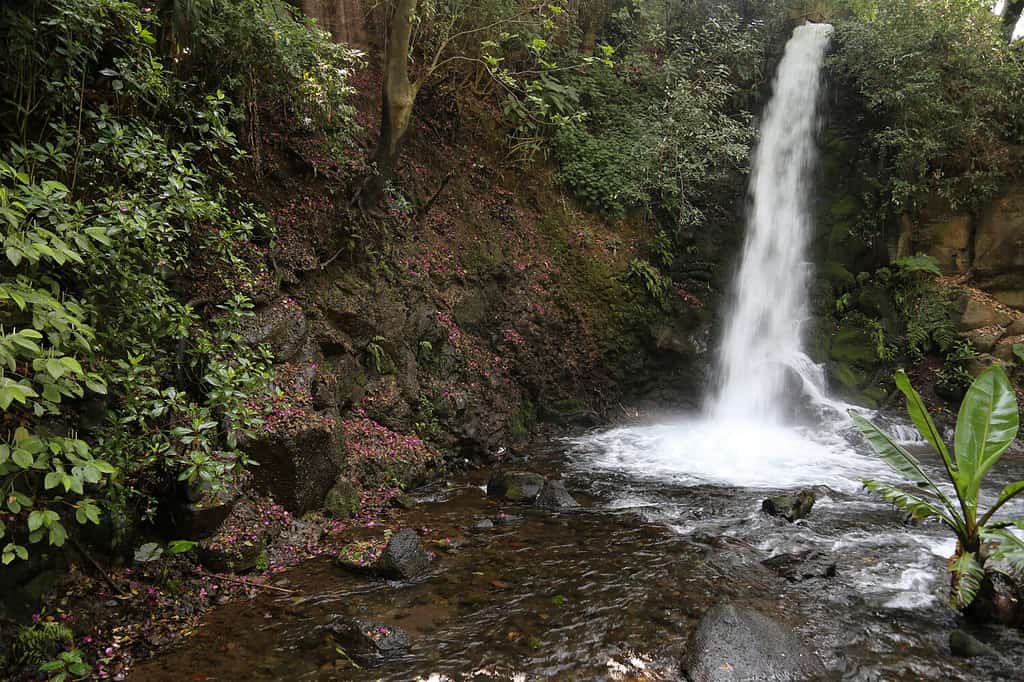Are you ready for an awe-inspiring journey into the heart of nature’s grandeur? Mexico’s monarch butterfly migration is a sight unlike any other.
Imagine millions of monarch butterflies painting the sky with their vibrant orange and black wings as they embark on an epic journey.
If you’re a nature lover or simply looking for a unique travel experience, witnessing the monarch migration in Mexico is a must.
Monarchs: Nature’s Wonders

The
monarch butterfly
is one of the more well-known lovely orange animals.
©Kate Besler/Shutterstock.com
Monarch butterflies are remarkable creatures that captivate the hearts of all who encounter them. These tiny insects undertake an extraordinary journey, spanning thousands of miles from North America to central Mexico.
But what makes them so special?
Epic Migration
Monarchs embark on an incredible journey that can span up to 3,000 miles, making it one of the longest insect migrations on Earth.
Generational Journey
It takes multiple generations of monarchs to complete the migration cycle. The butterflies that reach Mexico are not the same ones that left North America.
Winter Retreat
Monarchs gather in the oyamel fir forests of Mexico’s highlands, forming massive clusters that blanket the trees and create a surreal winter wonderland.
Remarkable Navigation
Despite their delicate appearance, monarchs have an innate ability to navigate across vast distances using the sun as their compass.
Now, let’s dive into the best places to witness this natural marvel and uncover the tips to enhance your monarch migration experience.
1. El Rosario Butterfly Sanctuary

El Rosario Monarch
Butterfly
Biosphere Reserve, Michoacan, Mexico.
©Noradoa/Shutterstock.com
Located in the state of Michoacán, the El Rosario Butterfly Sanctuary is one of the most famous monarch butterfly sanctuaries in Mexico.
This sanctuary provides a breathtaking sight as millions of monarchs cluster together on the oyamel fir trees. The sight of these butterflies is nothing short of enchanting.
The El Rosario Butterfly Sanctuary, nestled in the heart of the Michoacán mountains, is renowned for its lush oyamel fir trees, a key attraction for the monarchs. These trees provide the ideal microclimate, offering protection from harsh weather conditions.
Where to Stay: For a rustic yet charming experience, consider staying in nearby Angangueo. The Hotel Don Bruno offers cozy accommodations.
Getting There: From Mexico City, drive approximately 3.5 hours to Angangueo. From there, you can hire a local guide or join a guided tour to reach the sanctuary.
Best Time to Visit: Mid-November to early March is the ideal time to witness the monarchs in all their glory. The best time of day is in the morning when the sun warms the butterflies.
Tips: Wear comfortable hiking shoes and layered clothing. The trail is mostly uphill and mostly steps. Horses are usually available to make the trip uphill easier. Guided tours are available and highly recommended for a comprehensive experience.
2. Sierra Chincua Butterfly Sanctuary

Monarchs swarming at sunset in the Sierra Chincua Butteryfly Sanctuary.
©Dotted Yeti/Shutterstock.com
Also located in Michoacán, the Sierra Chincua Butterfly Sanctuary offers another mesmerizing glimpse into the monarchs’ winter retreat.
Sierra Chincua features striking landscapes and awe-inspiring views of the butterflies covering the trees. It’s a photographer’s dream.
Sierra Chincua’s unique topography provides a captivating habitat for the monarchs. The mountainous terrain and dense forests create a haven where monarchs can cluster and rest.
Where to Stay: Stay in Angangueo, which also serves as a convenient base for visiting Sierra Chincua. The Hotel Don Bruno is a good option for comfortable lodging.
Getting There: Drive from Mexico City to Angangueo and then proceed to Sierra Chincua with a local guide or guided tour.
Best Time to Visit: Similar to El Rosario, the best time to visit is from mid-November to early March, preferably in the morning.
Tips: Bring binoculars for close-up views and a camera to capture this natural spectacle. Don’t forget sunscreen and a hat for sun protection.
3. Cerro Pelón Butterfly Sanctuary

A monarch feeding on a stand of purple Tartarian asters in North America on their way south to Mexico.
©Liz Albro Photography/Shutterstock.com
Venture deeper into Michoacán to discover the hidden gem of Cerro Pelón Butterfly Sanctuary.
Cerro Pelón offers a more serene and less crowded experience, making it perfect for those seeking a tranquil encounter with the monarchs.
Cerro Pelón stands out for its serene ambiance and pristine environment. The monarchs are drawn to the peaceful atmosphere and abundant vegetation, making it an ideal roosting spot.
Where to Stay: Consider staying at the rustic yet charming Rancho San Cayetano in Macheros, a small town nearby.
Getting There: Drive from Mexico City to Macheros, and from there, embark on a hike to Cerro Pelón. Guided tours are available.
Best Time to Visit: Mid-November to early March. Early mornings are serene, with the monarchs often descending from the trees.
Tips: The trails can be steep, so wear sturdy shoes. Take your time to soak in the serenity of this unique sanctuary. You can rent horses and a guide to make the trip easier.
4. Piedra Herrada Butterfly Sanctuary

Parque Nacional Barranca, a beautiful waterfall near Valle de Bravo, Mexico.
©stacyarturogi/Shutterstock.com
If you’re near Mexico City, the Piedra Herrada Butterfly Sanctuary in the State of Mexico is your gateway to the monarchs.
This sanctuary is renowned for its unique topography, with monarchs frequently descending to drink from a natural spring. Witnessing this behavior is a rare treat.
Piedra Herrada is known for its natural spring, which serves as a source of water for the monarchs. The butterflies are drawn here for hydration during their winter stay.
Where to Stay: Stay in the charming town of Valle de Bravo, which offers a range of accommodations, including the luxurious Rodavento Boutique Hotel.
Getting There: From Valle de Bravo, it’s a short drive to the sanctuary’s entrance. Guided tours are available, or you can hike the trails to reach the butterflies.
Best Time to Visit: Late November to early March. The best time of day is in the late morning when the butterflies are most active.
Tips: Visit during weekdays to avoid crowds. The hike can be challenging, so be prepared with water and snacks.
5. Valle de Bravo

Monarch Butterfly in Valle de Bravo city center.
©Michael Zurawski/iStock via Getty Images
While not a sanctuary itself, Valle de Bravo in the State of Mexico serves as a charming base for exploring the monarch butterfly sanctuaries in the region.
Valle de Bravo offers a picturesque setting with its charming town, beautiful lake, and proximity to the butterfly sanctuaries.
While Valle de Bravo isn’t a sanctuary itself, its proximity to multiple butterfly sanctuaries makes it an attractive base for exploring. The town’s picturesque surroundings and pleasant climate also contribute to its appeal.
Where to Stay: Valle de Bravo offers a wide range of accommodations. Consider the Rodavento Boutique Hotel for a luxurious stay.
Getting There: Valle de Bravo is easily accessible by car from Mexico City. From there, you can arrange guided tours or transport to the nearby sanctuaries.
Best Time to Visit: Anytime from late November to early March. You can enjoy the town’s attractions during the afternoon after your sanctuary visits.
Tips: Explore Valle de Bravo’s dining scene and enjoy local cuisine after a day of butterfly watching.
How to Optimize Your Monarch Migration Experience
Now that you know where to go, let’s optimize your monarch migration experience with some essential tips:
- Weather Check: Keep an eye on weather conditions, as colder temperatures can keep the monarchs inactive.
- Stay Patient: Sometimes, the butterflies may take a while to become active. Be patient and wait for them to warm up in the morning sun.
- Respect the Sanctuaries: Follow all rules and regulations set by the sanctuary authorities to protect the fragile ecosystem.
- Bring Essentials: Carry essentials like water, snacks, sunscreen, and insect repellent.
- Guided Tours: Consider joining a guided tour for expert insights and a richer experience.
- Silent Observation: Monarchs are sensitive to noise, so keep conversations to a minimum while observing.
- Photography Tips: Use a telephoto lens for close-up shots and a tripod for stability.
Witnessing the monarch migration in Mexico is an experience that will stay with you for a lifetime. From the breathtaking clusters of butterflies in the sanctuaries to the serene beauty of the Mexican landscapes, every moment is a testament to the marvels of nature.
Now you know where to witness the monarch migration in Mexico, along with details about each sanctuary, where to stay, and how to get there. You’re all set for an unforgettable journey into the world of these magnificent butterflies.
It’s time to pack your bags, follow our recommendations, and get ready for an experience that will stay with you for a lifetime. Witness the monarchs in their winter retreat, and you’ll return home with not just memories but a deep appreciation for the wonders of our planet.
The photo featured at the top of this post is © David Trevarthen/Shutterstock.com
Thank you for reading! Have some feedback for us? Contact the AZ Animals editorial team.







